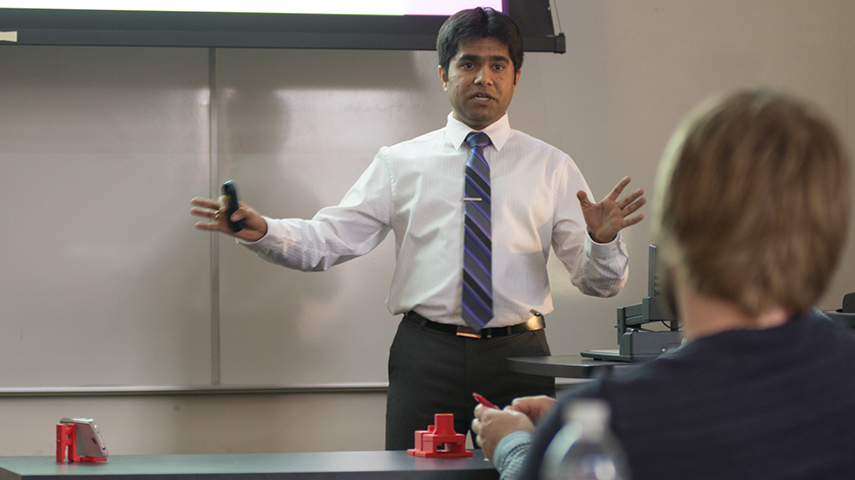Illinois State MBA student Aniruddha Godbole wanted to solve a simple problem: How could he watch movies and scroll through Facebook on his smartphone without having to hold it in his hands and crane his neck?
Godbole pitched an idea for a smartphone stand that you could carry in your pocket earlier this semester in his New Product Design and Development class. Three months later, Godbole and a team of colleagues have created an alpha prototype of the stand (see photo).
Going from a big idea to a product that could be brought to the market was a challenge, he said.
“It was a journey for all of us,” Godbole said.
Godbole’s team was one of five that presented their products May 6. The class had voted to pursue these ideas in February. The other products were a garbage can strap, a wine box stand, a shopping cart organizer, and a powder discharge unit for a fire extinguisher.
The class, composed of MBA students and Department of Technology undergraduates, bridges the gap between the two fields most responsible for developing and marketing new products. The students created the products in Turner Hall, the home of the Department of Technology, and presented them in the State Farm Hall of Business, headquarters of the College of Business.
For the second consecutive year, Technology Professor Louis Reifschneider and Marketing Professor Peter Kaufman designed the course such that student activities mimic the real-world process companies use to create and market new products.
Kaufman said he was happy with what he described as the students’ thorough presentations.
“The quality of projects continues to improve,” he said.
Near the beginning of the semester, the class was split into five groups based on the students’ experience and skills, and the results of personality assessments. Each student chose a different part within their teams—project manager, fabricator, product designer, and market researcher—but their roles overlapped throughout the semester.
Each team’s 20-minute presentation, which included videos of their market research interviews and customer testing, detailed the rigorous steps and iterative approach that are undertaken to bring a product to market. The teams had to develop a preliminary product design, determine the market size, get feedback on customer needs, design a product that met those needs, test their product with customers, and finally create a prototype—all in a single semester.
Godbole said his team determined there were about 150 million smartphone users in the United States but a smartphone stand market of only about 900,000 customers. The students decided that there was a need for an easy-to-carry, durable, and attractive stand after reviewing competitors’ products, which were out of stock, single-function, too pricey, or just plain ugly.
Early designs were tossed because the stands were too small or unstable. The team settled on a fold-up red plastic stand that would cost $2.05 to make and would sell for $6.99, and tested the product with 14 people. Team member Marshall Willis said getting a design that met all of the customers’ needs was the hardest part of the project.
“You’re not going to please everyone all of the time,” Willis said.
Kevin Bersett can be reached at kdberse@IllinoisState.edu.

